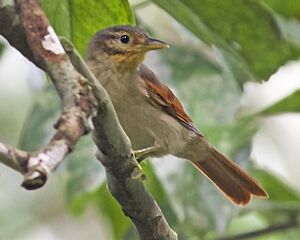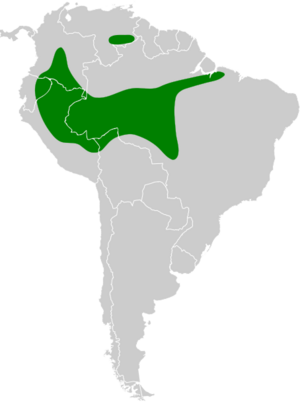Chestnut-winged foliage-gleaner facts for kids
Quick facts for kids Chestnut-winged foliage-gleaner |
|
|---|---|
 |
|
| Conservation status | |
| Scientific classification | |
| Genus: |
Dendroma
|
| Species: |
erythroptera
|
 |
|
| Synonyms | |
|
Philydor erythropterus |
|
The chestnut-winged foliage-gleaner (Dendroma erythroptera) is a cool bird that belongs to the ovenbird family called Furnariidae. You can find this bird in several South American countries. These include Bolivia, Brazil, Colombia, Ecuador, Peru, and Venezuela.
Contents
About Its Name and Family
Scientists often group animals based on how they are related. The chestnut-winged foliage-gleaner's scientific name is Dendroma erythroptera. It used to be in a different group called Philydor. But in 2011, many scientists decided it fit better in the Dendroma group.
This bird has two main types, or subspecies. They are D. e. erythroptera and D. e. diluvialis. Think of them like different versions of the same bird, with small differences.
What Does It Look Like?
The chestnut-winged foliage-gleaner is a medium-sized bird. It is about 17 to 19 centimeters (7 to 7.5 inches) long. It weighs around 28 to 36 grams (1 to 1.3 ounces). Both male and female birds look the same.
This bird has a wide, light brown ring around its eyes. It also has a faint light brown stripe above its eye. Its head is dull brownish-gray with light streaks. Its back and rump are dull grayish-brown.
Its wings are a special feature! The feathers that cover its wings are reddish-brown. The main flight feathers are also reddish-brown with dark tips. Its tail is a dark reddish-brown color.
The bird's throat is a yellowish color. Its chest is light brownish with faint yellowish-brown streaks. Its belly is a bit lighter. The legs and feet are yellowish-green. Young birds look similar but are a bit duller in color.
Where Does It Live?
The chestnut-winged foliage-gleaner lives in tropical forests. These are forests that stay green all year round. It prefers forests on higher, drier ground, which scientists call terra firme forests. But it can also be found in forests that flood, known as várzea forests.
You can mostly find this bird up to 500 meters (1,600 feet) high. But sometimes, it lives as high as 1,200 meters (3,900 feet) in the mountains.
How Does It Behave?
Staying in One Place
This bird does not migrate. It stays in the same area all year long.
What Does It Eat?
The chestnut-winged foliage-gleaner eats arthropods. These are small creatures like insects and spiders. It usually hunts for food in pairs. Often, it joins groups of different bird species that are feeding together.
It mostly looks for food in the middle and top parts of the forest. It is very agile! It uses its beak to pick prey off leaves and small branches.
Bird Sounds
The song of the chestnut-winged foliage-gleaner is quite unique. It sounds like a fast, buzzing, and slightly shaky trill. This song lasts for about two or three seconds.
Its Conservation Status
The IUCN (International Union for Conservation of Nature) checks on animals around the world. They have listed the chestnut-winged foliage-gleaner as "Least Concern." This means it's not currently in danger of disappearing.
Even though its population might be getting smaller, it lives in a very large area. Plus, it can be found in several protected areas. This helps keep the species safe.


